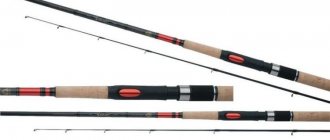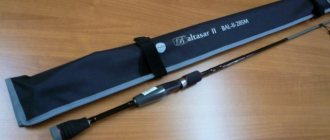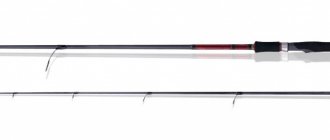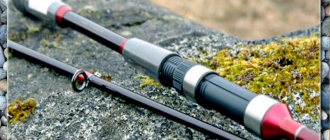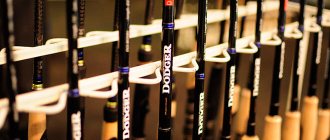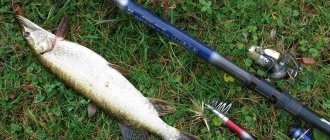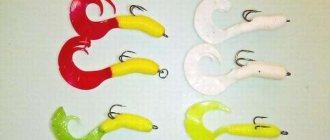This gear is not for big men and not for idiots! At first glance, it seems that catching perch with loads of 50 g or more is unwise. You need to be able to do this and, in the end, you need to grow into it. This is not the purpleness of the fish; the purpleness has nothing to do with it. The tips of the hooks are sharpened and hidden, the Cheburashkas are collected in a locomotive. I want to surprise those who have never caught a heavy jig with a spinning rod, but only smiled at it. After reading this article, you may change your mind about a heavy-class spinning jig. Well, if you are reading these lines, then the topic is no longer uninteresting to you.
How did I grow into heavy jig spinning?
A heavy jig spinning rod (Heavidjig) catches, has caught and will catch everywhere! How did I grow into heavy jig spinning? I haven’t been fishing with spinning for very long. I started with small rivers. I realized this is not for me. Weight 5 g. - that's not mine.
Not a long retrieve, bites near the shore, fish on the shore after 15 turns of the reel handle - not my thing. Of course, I received pleasure from such fishing, but there was some discomfort. Trips to the Volga in February played a role. The struggle for casting distance (the most pressing topic among local spinning anglers), 4 Ib cord and 6 g weight is not the same... It flies, catches, but not the same, not mine!
One weekend we were on the Volga, I fished with thin braid and 6-gr. cargo A friend caught a 16-gr. Both had the same bites. A thought arose in my head: why put a light load and torture yourself by tracking the retrieve with a light jig head? At that time I had many doubts: it was winter, a passive predator, I needed the lightest possible load. Is it worth it?!
Previously, when I put on a heavy load, I would make several casts if there was no shooting. The wiring scared me a lot, so I put on a light bait again. What is all this for? Besides, there is no need to be afraid to deviate from standards. Non-standard wiring, minimal pause. And what?
I didn't think so before. There were a lot of weights in my box, but the 30 gram weight was a “stumbling block” for me. I hung it like that from time to time, just to fool around, and thought that no normal fish would bite on it. All this happened until I caught the asp in the shallows with a load of 28 g. The step was short, or rather there was almost none at all, but the fish bit, and this became another progress. Then I forced myself to catch a pike at 32 grams, and from then on it went. I don’t remember when my spinning rod threw a load lighter than 30 grams.
Another episode. Dubna river. I fished with a friend, he had 10 grams. the load is the head, and I have 50 grams! As a result, I got three bites, pulled out two pikes, and my friend ended up with zero that day. All bites occurred in a new place on the first cast. And what conclusion do we draw? A heavy spinning jig (Heavidjig) is an active search and catching of active fish!
Or there was such a case. We arrived on the Moscow River in the Kolomenskoye area. The day before, a friend called me and said that heavy jig spinning rods (heavy) were not fishing there. An ultralight will do, and the perches will find themselves. I listened to him, of course, but still decided to do it my way.
I went out to the river bank, and after several long casts I caught an asp! I won’t say what weight I fished with. Still won't install it. But there was no step, and, in general, there was no pause.
So, I didn’t give up and got results, and that’s the main thing. You can force yourself, but you have to want to. I fish the way it suits me, and the most important thing is that I like it. I do it easily, it doesn’t always bite, it wouldn’t be true if I said that I always catch. Deep or shallow - I put as much as my heart desires! You have to fish uninhibitedly. Proven spinning rod, thick cord, powerful reel.
How to choose a sinker weight for a jig
If the current is too strong, there is no sag in the line, and therefore you have to control the wiring only by observing the tip of the rod. In such conditions, the spinning rod can be held at an angle to the horizon or even in a position parallel to the shore.
Relative to the vertical plane, the tip of the rod is held at an acute angle of 45-50 degrees, so that the line comes out of the tulip of the rod at a right angle. This position of the spinning rod will make it easier to track the contact of the bait on the bottom of the reservoir.
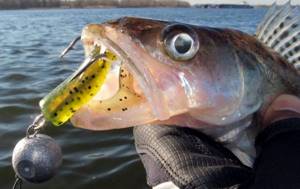
The wiring diagram may vary. For example, the following method is considered a classic: 3 turns of the reel, pause, drop the bait for 2-3 seconds and touch the bottom, and then repeat all actions. During such a retrieve, the movement of the bait is a system of smooth jumps at the very bottom of the reservoir.
Another wiring option is this: we sharply raise the spinning rod about 1 meter up and lower it back, picking up the slack in the line using a reel, and then pause for 2-3 seconds. With such actions, the bait rises sharply from the bottom and then smoothly falls back, provoking predators to attack. To achieve the best results, you need to constantly experiment with wiring, without stopping at just one method.
Spinning in a heavy jig
I am surprised by the spinning players I know. They always tell me: “Aren’t you afraid of breaking the spinning rod from such casts?” Yes, I cast with all my heart, fortunately the spinning rod handle of the proper length acts as a good lever. I don't care about casting distance, I think it's stupid. It may be necessary, but not always.
There is no need to worry about the module, test, or structure of the spinning rod. Sensitivity? It is not needed in a heavy jig spinning rod (heavy jig), such weights will hit your hand willy-nilly, the main thing is that the form of the spinning rod does not bend slightly above the handle when reeling in. I have inexpensive spinning rods, I don’t need expensive ones, I have my own philosophy. I don’t think that if you put an expensive spinning rod in my hand, I’ll catch more.
This is all nonsense! Strength is not in the “module”, but in the head and arm muscles. Good old Whisker. Not the one you see in stores now, it's stupid and much heavier than its predecessor. A friend helped me buy an old one, and I am extremely grateful to him. There is no need to feel sorry for the spinning rod, it should work. If you're afraid of breaking it, it's better to leave it at home!
Let's understand the terms...
For me, heavy jig is always difficult fishing along the terrain, taking into account some local features of the river section. In order not to get confused, I’ll note right away that in my understanding, the weight of a jig is determined primarily by the weight of the load and then by the size and weight of the bait. Fishing with heavy large silicone baits, in my opinion, is one of the techniques of modern jig spinning, but not heavy jig spinning. Anyone who is at least somewhat familiar with fishing with shad-vibrating tails measuring 6 inches or more knows that their fabulous nickel-tails, if the load is too heavy, lose all their attractiveness to fish. Large, massive, heavy Shad not only require “underloading,” but also reveal their full potential by hovering on long steps in the water column above fairly large depths, remaining as long as possible in the hunting grounds of pike perch and provoking them to bite with the play of their powerful tails. Again, the correctness and stability of their play is very dependent on the strength of the current and the direction of the retrieve. In a weak current, large rubber extremely consistently produces the required rhythms on various fishing trajectories, but in a strong current, it almost always needs to go against it; as soon as such a bait gets across a strong current, and even in an area with shallow depth, all the above-described advantages of large rubber disappear, Due to their windage, the steps turn into poorly controlled passages, and casts when fishing places can only be downstream. And in order to throw a 6-inch bait on a jig head from the shore to the coveted relief, which can be 60 or 90 meters from the shore, you need to try very hard. This is largely why, and despite constant experiments with large baits and certain successes, this technique has not really caught on with me.
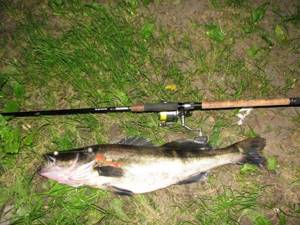
A trophy specimen caught on a large shad from a long pause, from the macrorelief
For many seasons, when fishing from the shore, my priority is heavy sinkers of various shapes, hinged rigs and compact lures.
A deliberate increase in the weight of the load when fishing from the shore in my fishing conditions has certain advantages both for technique and for fishing tactics. The first obvious plus is that compact baits equipped with a 60 gram Cheburashka are easier to cast over long distances when fishing on the shore. In order to effectively fish the site of a potential attack and provoke a predator to bite, in 90% of cases it is necessary that the deployment of a heavily loaded bait begin at a distance from the predator’s ambush. I believe that monotonous and sharp impacts of a heavy load on the bottom approaching an ambush or varying in amplitude, and the suspension rising from the bottom with each impact not only do not scare off a large predator, but on the contrary attract its attention and force it to turn on an indicative reaction and tune in to a further attack. A heavy load and a short pause are not a hindrance for large fish; the bites amaze with their anger and determination.
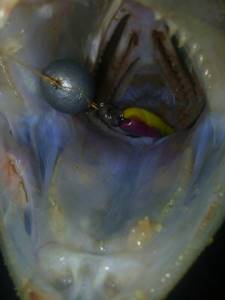
A load of 52 grams of Cheburashka and a bait of more than 10 cm were lost in a large pike perch
Let me note that anyone who catches pike perch from the ice in winter knows that it happens that it is precisely tapping the bait on the bottom with further detonation of the bait from the bottom that attracts and provokes fish to bite.
No less important are both the wiring itself and its trajectory. Since the places are extremely local, and the current is not weak, another obvious advantage of a heavily loaded bait is its better controllability. This is what guarantees that the retrieve at all its stages, namely from getting the bait into the water to approaching the local shelter and meeting the predator, will take place consciously. Postings, of course, can vary in speed, trajectories, and tempos. Very conditionally, I highlight for myself:
1. Monitoring, i.e. covering a larger area in less time. 2. Provoking - with any changes in the trajectory of the bait’s passage over the “local” place. 3. Mocking - according to the principle, there is a lot of noise at the bottom - large predatory fish, as I already noted, are contently curious. 4. Free - where upstream casting prevails, and all we have to do is adjust the line’s trajectory with the rod and reel and let the current correctly carry the bait to a “local” place. 5. Posting 4-5 steps with a powerful toss over the potential parking point of the predator.
A number of my comrades believe that with the right weight, type of bait and speed and technique of wiring, the behavior of a heavy jig bait under water becomes more like a trolling wobbler scratching along the bottom than a conventional jig with a step. I think this is more of a special case than a trend.
I don't see any point in going into more detail about the wiring. Everyone knows that you can talk for a long time about how to ride a bicycle, but these stories in themselves do not lead to riding skills without practice. Let me note once again that the most important thing is to control the behavior of the bait throughout the entire wiring.
In a heavy jig, mounting with a hinged connection between the weight and the bait is a priority. And there are reasons for this. With this installation, the bait and weight are folded, creating less windage during casting. The center of gravity shifted forward provides better control when retrieving and gives a greater degree of freedom in the game of the bait. A heavy hard load spaced from the silicone bait with the help of winding rings creates a certain turbulence and vortices that are transmitted to the playing bait, thereby forming a certain hydrodynamic trail that attracts a predator.
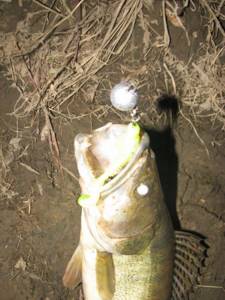
“Articulation” is important in catching not only trophies
Talking about fishing, I can’t help but touch on the topic of the gear I use. Since the weight of the weights used together with the bait can vary from 42 to 80 grams, over time I have a clear idea of what kind of rod I need. Over the years of fishing, I have tried quite a large number of spinning rods.
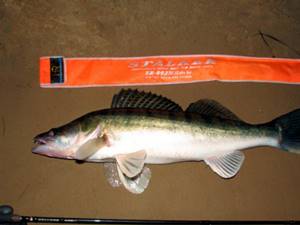
Trophy 2013
I had purebred “seabass” Japanese, which in my opinion did not have enough power when hooking, I had long-range shorjig rods, amazing with power, but not very sensitive, Americans, Koreans, excellent New Zealand CD Rods, excellent Hearty Rize spinning rods from Taiwan. Some rods were delayed, some left after 2-3 fishing trips. The feeling that every time you were trying to adapt gear for a different fish to suit your conditions did not leave you. And since 2013, I have been actively using spinning rods under the FOX RAGE brand in the TERMINATOR BAIT FORCE 285 and TERMINATOR BIG BAIT SPIN 300 lines.

Rods can be different, the main thing is that they are reliable and of high quality
In my opinion, the rods have absorbed all the qualities needed for trophy fishing and heavy jigging. Rigid, with a pronounced fast action, powerful, not falling through when casting and hooking, having a wide test and excellent sensitivity - for me they became those fishing rods that fit 100% into the ideology of my pike-perch fishing. And this year my arsenal was replenished with an updated rod from the FOX RAGE TERMINATOR PRO BAIT FORCE 285 series. I will not dwell in detail on the characteristics of the new rod, but I will note that the updated version, without losing power when hooking, sensitivity and ringing when retrieving, has become clearly more interesting when casting and when landing large fish.
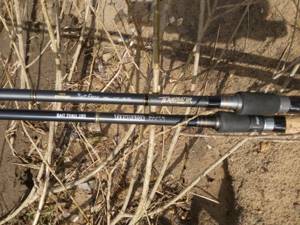
FOX RAGE TERMINATOR BAIT FORCE 285 and FOX RAGE TERMINATOR PRO BAIT FORCE 285
The reels used with the rods are traditional heavy-class power ones from SHIMANO and DAIWA. These are the old proven models TWIN POWER 02 PG and SALTIGA GAME. The power of the reels allows you to work with baits of any weight, setting the desired pace on the retrieve, and their reliability has already become a legend.
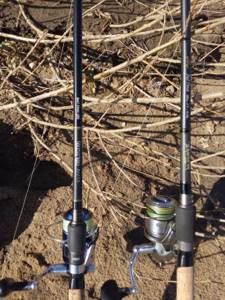
Competent work kits
LURE
I fish mainly with foam rubber. Whatever one may say, twisters and other silicone products do not suit me. The fact is that the twister on the double in our case (with a heavy head) very often “catches” the fish by the tail, back, etc. That is, it’s purple! This is absurd! We are not animals, by God. Let the poor fish live. And you can buy cutlets in the store.
I make the “foam rubber” myself. Runaway, short and whatever. I don’t strive for accuracy, I don’t need it and it’s of little use! I try to use stronger doubles, sharpening them with a pebble. I make all baits in a non-snacking form. The main thing when gluing is not to overdo it with glue, otherwise the foam will lose its softness.
A twister on an offset machine, of course, has a right to life, but after an empty bite, the twister comes off the hook, thereby minimizing the likelihood of a second bite on the same wiring.
I don’t need hooks, and I’m not a fan of catching fish! When retrieving the bait I use a standard “step”. I don’t use any swaying, much less twitching. Big or small pause, who said there should be one?! Catch it and that's it! The main thing is not to adhere to any standards, this is stupid. Every spinning player must be original.
Trophy pike perch - how much in kilograms?
Of course, every fishing enthusiast, answering the question of what size fish he considers trophy, will answer based on his experience. For a beginner, a 2.5 kg pike perch is already a significant trophy; For many seasoned zander fishermen, trophy weight starts at 6 kg. My opinion is that for our region, fish weighing 5 kg or more are already considered trophy. The fact is that the question of whether a representative of a particular species is a trophy is, in my opinion, directly related to the habitat in which this species lives. At first glance, modern Oka in the Kaluga region is not a very good place for large specimens of pike perch to live. Waterlogging, shallowing of the river, fishing and poaching pressure also affect and contribute. However, from 2008 to this day, catches of fish weighing more than 5 kg are not so rare, which is certainly encouraging.
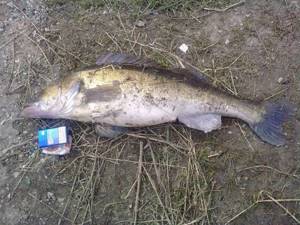
Pike perch over 9 kg are not that uncommon to this day
According to my personal 10-year statistics, the most common trophies that are caught in the summer season are pike perch weighing 6 kg or more. These are certainly significant trophies - the dream of any fisherman, but along with these trophies, my friends and I also come across super pike perch weighing more than 9 and 10 kg throughout the open water season. And all this happens not somewhere on the northwestern hidden lakes or in the vast expanses of the huge Volga reservoirs, but on the pressed-in Oka 40 region, on a section of the river where depths in summer rarely reach more than 4.5 meters.
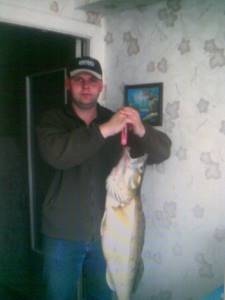
There was a time when the author did not let seasoned pike perch go
LEASH
I tear the store bought ones with my hands! Seriously. I'm not a jock, it's just that the quality leaves much to be desired. It is such that half of the leash with the bait flies away while casting. I make them myself from #2 guitar string. One string makes three leashes. This has been my standard lately. The fact is that very often the pike attacks the jig from the front, as if “running over”
teeth on a piece of fishing line in front of the bait. As a result, no bait, no fish. Therefore, it is better to be more authentic.
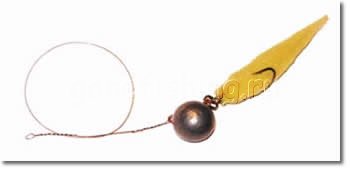
I make the twist tighter and longer. We use a thick cord, and therefore a weak twist on the hook can easily fail. Let's return to the process of finding fish. The spinning rod is in your hands, the reel is already in anticipation of the upcoming loads, the load is ready to break the shell of water. You and she are all one! Power, simplicity and thought - everything merged into a single whole. I made a cast - the “dredger” began to work, watch the reel, don’t let the loop happen so that on the next cast you won’t reach the Moon.
I mostly release the fish, this is perhaps the best reward for the feat that it accomplished! Why put less when you can hang more, why choke with “pencils” when you can “pull yourself together” and catch a crocodile!? It makes me sad to see what I see while fishing. People are afraid, afraid of not catching fish! They strive to do everything for the sake of capture. Walking weight, catchy color and slippery cord. It’s sad when people are constrained in their opinions and actions - everything is according to standards. They are afraid to go beyond the limits. It’s sad that there is no one’s own opinion, but only the opinion of the notorious “experts” from the TV screen or from the pages of a magazine. I went my own way, micro jig is not interesting to me. No offense to fans of micro fishing! Just to each his own!
It is important to respect the opinion of another, that’s why he is different! It's sad that everyone copies each other. They rush to who knows where to catch more. People are afraid, specifically they are afraid to move away from stereotypes. I always act at my own discretion. The principle works: “listen and do it your way.” Fishing is, first of all, relaxation, a holiday for the soul. So make sure that every fishing trip becomes a holiday for you, and not a race for something!
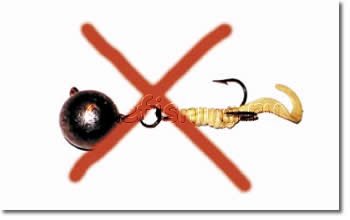
When fishing, I rely on an active search, trying to cover the maximum area of the reservoir in a day. And, as a rule, it gives results! Don't be afraid to fish in shallow water, who knows what's on the fish's mind. If, in the process of “punching” the water area, miraculously there are so-called bottom anomalies, I methodically fish for them. The load bounces along the relative plain and suddenly falls somewhere. Don’t be lazy, make a few more casts there, and the fish, if it is “attached” to this place, will try to catch up with your bait. Very often a snag was found, and soon a pike.
Just, for God’s sake, don’t engage in “uprooting trees” or leave the fish without a home.
I rarely use twisters: when fishing for perch. Color doesn't matter. Don't worry about color, softness, or even play. In the same already well-known Zhestylevo, I happened to catch perch in a creek behind the forest. Weight 20 g, double No. 1 and medium twister. It pecked well, the bay was small, there was no pause, as always. But he bites!
And here's another one. Tournament "Kremlin Domes". Guys are running around, throwing microjigers, or rather, trying to throw their ultralight “twigs”. And here on you, a friend with a 48 g weight catches a perch in front of one of the “miracles”. You should have seen the latter's face!
A little about baits...
However, all descriptions of installations and features of wiring, equipment and interesting places become meaningless if the topic of baits is not touched upon. The general idea of baits for heavy jigs was best expressed by the most experienced fisherman Sergei Savin - the bait should be long and thin. Sergey Savin actually formulated all those classical principles that are still used in heavy jig spinning. Over the years of fishing, having tried many different silicones, I cannot but agree with him. Another thing is that not all long and thin baits work equally well with heavy loads. It is still not completely clear to me why baits that look different from white fish as the main food item for trophy pike perch are so popular among them. While I will not share my thoughts on this topic, I can only state that among the long and thin ones from my arsenal, there are clearly those on the list that seasoned pike perch like. If I were asked to choose a few from the entire list and put them in a box, then my choice would fall on three diverse lures. I hope my choice will be interesting.
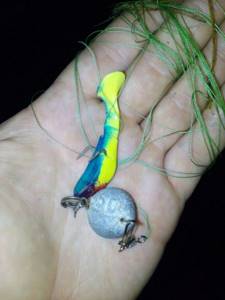
The bait is not a heavy jig. 50 gram Cheburashka kills the game of this vibrotail.
In the twister class for heavy jig and heavy pike perch, I would choose the current classic ACTION PLASTIC 5FG, also known as Action Plastics 4″ Curl Tail Grub. In the last 2 years, I have met many spinning anglers on the banks of the river, and few people know about this bait, which surprises me. In my opinion, the 5FG is like a Suick in a jerk for a jig. 5FG are high-quality twisters with an elongated shape, which have excellent and most importantly stable play with heavy loads. No curdiness, stupid edibility, only dense and high-quality material typical of all classic Americans, a wide range of colors, small windage for long casts and the possibility of various equipment and caught trophy pike perch make me choose it.
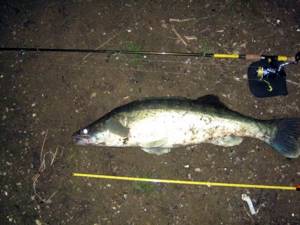
5FG +44 grams and pike perch a little more than 8 kg
I am less confident in the long vibrating tail class than in twisters or worms. There is not much choice here, but in general the stability of fishing in heavy jigs with them is not high. The choice is not easy. A proven classic or a proven, but still relatively new bait, what to choose?
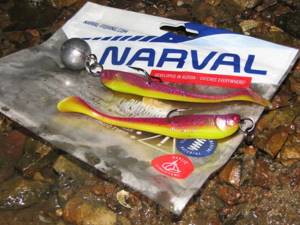
Slimm Minnow 11 cm + 52 grams
Perhaps I’ll choose the newcomer Narval Slim Minnow in size 11 cm. The bait is similar to both a slug and a vibrotail at the same time, following a heavy load smoothly and clearly on various retrieves, durable material, interesting colors and several fanged trophies over 5 kg this season. The equipment is classic articulated.
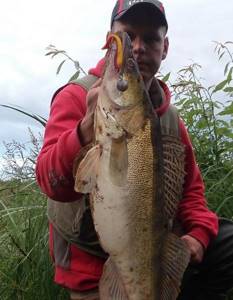
Pike perch weighing more than 6 kg
In the class of the best silicone worm for pike perch, I definitely opt for the Action Plastics 6" Curl Tail Worm and for good reason. Action Plastics Curl Tail Worm 6" is a bait in the form of a long worm with a twister tail. I don’t remember how many years have passed since the first time I threw this bait into the water, in 2010, maybe earlier, I can’t say for sure. I can only say that these baits have repeatedly demonstrated their catchability.
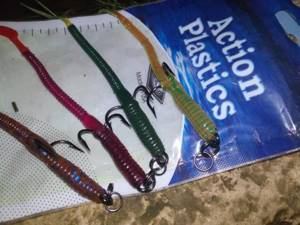
Action Plastics 6″ Curl Tail Worm are the coolest
There are many similar models, there are copies from other manufacturers, but the action curl tail is the coolest of all. Copies don’t stick out like that, raising their tails at the bottom and wagging their tails; similar ones don’t flow so invitingly on the wires. The material is dense, but does not kill the game like a number of copies where the “curdiness” or “oakiness” spoils everything. Like all Americans, this worm is perfectly mounted in a hinged design, but like all worms it requires its own approach to wiring.
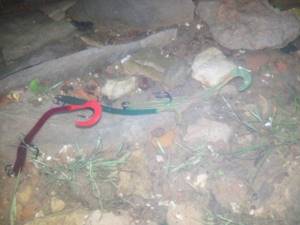
Very cool "waving" tail
It’s worth pushing hard, experimenting for seasons 3-4 and the results will come. After all, it’s hard to argue with the most important argument of this season, the 112 cm long pike perch.
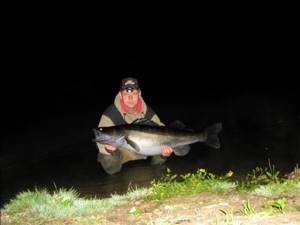
A weighty argument!
That's all about bait for now. I will say that I mainly mount baits on EAGLE CLAW 2957 DBP 1/0 or 3/0, unlike most “Asian” hooks with their chemical sharpening, mechanically sharpened American ones, although not so sharp, are excellent at meeting the terrain and being corrected .
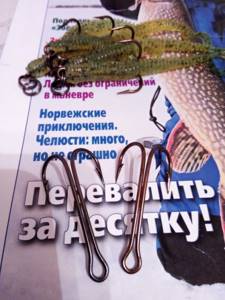
EAGLE CLAW 2957
Well, it seems like I paid attention to a little bit of everything in this little fishing article. I hope those who read to the end found it interesting. It was difficult for me to fit into a short note a description of not just one fishing trip, but several years of fishing experience; I was left with a feeling of unsaidness and incompleteness. There are still many interesting points regarding trophy pike perch and spinning jigs. I think there will be time, and I will also share this experience.
I wish you all a trophy autumn, let's live and catch!!!
A FEW WORDS ABOUT ASSP
The situation with the asp is very interesting. It flies in unexpectedly when, in principle, you don’t even expect any fish. Fact! As soon as you caught a decent asp in Kolomenskoye, hunters immediately appeared for him.
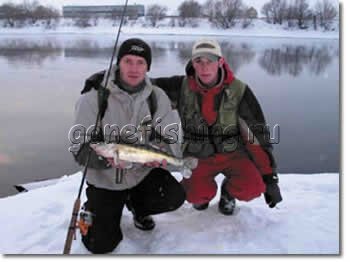
The asp always gets stranded. If you consider that the load weights used in “heavy jigs” often exceed 30-40 g, you can imagine that the wiring in this place turns out to be very specific. However, the asp is caught! This is a very strong and fast fish; it is not difficult for an asp to chase the bait that is madly rushing past. Besides, it even amuses him.
Most often, the asp finds itself in places such as shallow river riffles. Particularly attractive are places where the shallows border the depths and there is a fast current. The asp loves the current. Bridge supports are very attractive to him. Everyone knows a place that is stable for asp - Bronnitsky Bridge, they are caught there all the time.
It's biting again! You just have to load your spinning rod, be patient and go “bombing”. You'll definitely catch it!
Jig fishing from a boat all year round
Fishing with a jig. Recently, jig fishing for predators from a motor boat has become an increasingly popular activity. This kind of fishing is characterized by mobility, with it all areas of the reservoir become accessible. We can confidently say that those who fish from a boat have higher catches. Even with modern gear, it is not always possible to reach the predator’s favorite stopping places from the shore.
This is especially noticeable in autumn and winter, when fish move away from the shores, choosing the deepest places for themselves. Meanwhile, in our opinion, the best time for fishing is from the end of September until the first frosts in November. The bite at this time is stable, lasts throughout the daylight hours, and the bites are very strong. It is during these months that the largest catches occur; large asps are often caught...
Another factor forcing spinners to move from the shore to the boat is caused by the ever-increasing fishing pressure on water bodies in the Moscow region. You get disappointed when you arrive at your favorite place and discover that you are not the first there. How can you not daydream about the cherished edge, where no one has been before you...
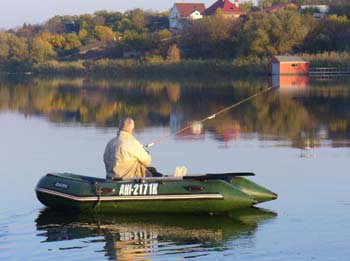
Jig fishing - from a boat
Another unpleasant situation when fishing from the shore: the hole is located 3-5 m from the water’s edge, and it is impossible to carry out fishing from the bottom up due to the steep slope; the bait constantly has to be “pushed” along the slope. It’s a shame, because such a place is a potential stop for a predator. You can fish from a boat both in summer and winter, if, of course, the air temperature is above -5°C.
In recent years, the climate of the European part of Russia has been giving us big surprises in the form of warm winters with prolonged thaws. Last winter, frosts down to -10°C in the Moscow region lasted from mid-December until January 15, then, with the exception of a few cold days, there was above-zero temperatures. You can hide from the wind in the leeward sections of the river. Let us dwell in some detail on what equipment and tackle should be for such jig fishing.
Boat, motor, accessories
We use a two-seater boat made of modern rubberized material with a hard bottom, which gives stability when casting and jigging. It has two seats, consists of several inflatable compartments, and even if one of them is punctured, it remains buoyant. The boat should not be pumped too much. Because As a result of changes in weather and air temperature during the day, the pressure in the cylinders changes.
Especially in the sun, when the sides are exposed to strong heat. This note is especially true for those who use old boats or vessels of questionable manufacture. In addition to the outboard motor, the boat must have oars, an anchor, a landing net, life jackets for the number of people wishing to sit in it, and an electric torch. As well as a pump, a bailer, a first aid kit, a repair kit, and signaling equipment (PRB-40 missile).
There are areas on the Oka about 300 m wide; in strong winds, high waves form on them. Riding in such places is very similar to riding a scooter. The boat, bouncing on the wave, crashes into the next one with a powerful blow. You have to hold on tight so as not to fall overboard. It is clear that at such moments it is better to wear a life jacket. The motor, no matter how offensive it is for Russian manufacturers, is better to use an imported one from well-known companies.
General requirements for the engine: reliability, quick start, efficiency, low noise and vibration levels, low exhaust gas content, relatively light weight. If the engine meets them, then even in sub-zero temperatures there will be no problems with its starting and operation. To get to planing quickly, the size and weight of the boat must be combined with the power of the engine.
So, for example, for a two-seater boat weighing 30 kg and length 2.80 m, an engine with a power of no more than 15 hp will be required. The weight of our engine is 38 kg. An anchor for such boats requires no heavier than 5 kg. It is important that the length of the anchor rope be at least 20 m. On the Oka we know of a couple of places with a depth of 25 m. If your load is not heavy enough, then even in strong winds or currents, you can anchor securely by increasing the descent of the anchor rope.
There is only one rule: the sharper the angle between the direction of the rope and the bottom, the stronger the boat will stand. It is worth noting that on the Moscow River, due to the high probability of snags, anchors with long hooks cannot be used. Everyone knows about the high sound transmission of water, therefore, upon arrival at the fishing site, the anchor should not be dropped, it must be carefully lowered, without creating an impact on the water and the bottom, and in general you need to be quiet in the boat.
One day we went fishing with a friend. He told different stories with indescribable delight. The fish liked it the most. As a result, we went to the theater for free and didn’t catch anything. Think about who you are going fishing with and how psychologically compatible you are: you won’t spend the whole day at arm’s length with everyone.
Do you and your partner have a mutual understanding while fishing, how clearly do you communicate, do you pay attention to your partner’s actions when casting - all this is very important for the mutual safety and integrity of your gear. One important note: a boat used with an engine must be registered with the GIMS (State Inspectorate for Small Boats), for which a corresponding document is issued. For engines over 10 hp. A boating license is required.
Jig fishing - reservoirs
Due to the proximity of the location and convenient access, most of the capital's spinning anglers fish on the Oka and Moscow rivers, the current strength of which is up to 0.5-0.7 m/s. These rivers are attractive for their depths, bottom topography, and fish species composition. When fishing from a boat, we are primarily interested in deep sections of rivers with a “hard” bottom.
On them you need to look for steep slopes, channel edges, entrances and exits from holes, snags, and any other changes in the bottom topography that form natural shelters for a hunting predator. Each such place can be potentially successful. It has been noted that on the Moscow River there is no more than 200 m between neighboring pits, while on the Oka they are approximately 1 km from each other.
In a day you can explore 5-7 promising places, and half of them will be “empty”. Every year after a flood, the bottom topography of rivers changes. Sometimes it happens that part of a previously familiar pit with a clay bottom turns out to be silted after a flood, and at the same time there is no more silt in other places. You will find more detailed information about spinners for pike “spinners” here.
For winter spinning fishing, the most suitable area is the Oka River, which does not freeze due to the discharge of warm water from the Kashirskaya State District Power Plant, and the Moskva River, which is always open, even in severe frosts, in the area from Moscow to Kolomna. In winter, after the water has drained, the bottom topography on the Moscow River is so unpredictable that swimming at high speed is very dangerous - there are many riffles littered with snags, concrete piles, reinforcement, and other debris.
You can avoid emergency situations only by carefully monitoring the speed and direction of the flow - in places where there are underwater obstacles, turbulence or other changes in the flow of water are formed.
Fishing objects, their habitats
The species composition of fish caught with a spinning rod on the Oka and Moscow Rivers is common for central Russia: pike, pike perch, bersh, asp, perch. It is still too early for us to systematize catching chub and ide with jig baits. Cases of their capture are relatively rare and mainly occur in shallow sections of rivers with fast currents and a hard bottom.
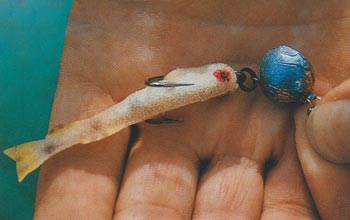
Jig fishing - the undisputed favorite among baits is foam fish
Fishing for catfish and burbot in these sections of rivers has been mentioned only a few times by anglers over the past five years. Since we fish mainly in deep areas, we will try to talk about the predator’s attachments to these particular places. The main thing is the presence of a hard bottom: clay, small stone with sand.
In silted areas there is either no predator at all, or very few. The location of a predator is influenced by many factors: time of year and day, weather, pressure, lighting, water and air temperature, water turbidity, but the main one is the food supply, which, in turn, is influenced by the same conditions.
Pike rarely lives in areas with fast currents. It can be located and hunt in any part of a hole, riverbed edge or snag. Fish weighing from 1 to 3 kg especially prefer exits from pits. There is one more feature - the larger the fish, the deeper it is. On the Oka there are several creeks in which there is no current, and the depth there is up to 8 m; a sharp drop begins from the shore. Large specimens are found in these places.
It has been noticed that sometimes, in early autumn, medium-sized individuals form small schools, and several pike can be caught from one point. At the same time, large specimens (from 2 kg) stay apart. Pike bites are usually clear and sharp. Pike perch and bersh on the Moscow River and Oka usually form joint schools of up to 10 individuals.
Only in early spring and late autumn do they gather in groups of up to 50 individuals, and on the Oka River up to 30% of the flock are bershi. Specimens of pike perch weigh from 400 g to 2 kg, bersha - from 300 g to 1 kg. These fish, on the contrary, love a fresh flow of water. Their favorite places are channel edges and sharp drops with a medium current. The pike perch bites are clear, but often it presses the bait to the bottom.

Jig fishing - choosing bait depending on the month
Bersch rarely takes during a pause; he usually grabs an already fallen bait, but more often he covers it with his lower jaw, pressing it to the bottom - apparently, this is due to the absence of fangs. Pike-perch weighing more than 3 kg always stay apart due to their weight and size, as they say, “they don’t take them into a flock - they’re too dangerous.”
Perch stays separately or in small schools of up to 10 specimens on the upper sections of drop-offs and edges and on extensive plateaus with an average current and a depth of 4 meters. On September 12 last year, at one of these places, in the area where the Kashirka River flows into the Oka, we caught 56 perches weighing from 300 to 700 g using foam rubber fish.
A large flock “occupied” the plateau for only one day, and there were bites on every trip. In the following days the situation was usual for this place - 5-10 fish caught. Favorite hunting spots for perch are various underwater mounds. The perch bites are sharp, but not strong. Very often, before he grabs the bait, he chases it for a long time and hits it several times.
The asp feeds in open areas with strong currents and depths of up to 4 m; its flocks are few in number. He is shy, after catching one or two specimens, you can change the place. However, oddly enough, you can approach it by boat at a distance of up to 20 m, the main thing is to maintain silence. In summer, the asp’s main habitats are backwaters where his favorite delicacy, bleak, lives. The bites are so sharp that sometimes a predator can snatch the spinning rod out of their hands.
Jig fishing - gear
Jig fishing from a boat is done with the same gear as from the shore on large rivers. Let's start describing them with baits. We prefer front loaded ones, of all types. The most catchy and most frequently used is the foam fish. We gave her first place because... it has proven itself well in almost all conditions.
Depending on the time of year and the stability of the bite, we use fish of several sizes, colored like minnows: the smallest in winter and spring, medium in summer, large in autumn and summer with a stable bite. This bait is easy to make and inexpensive, even taking into account that the consumption of baits in some places, especially on the Moscow River, is very high, up to 20 pieces per day of fishing.
In second place are twisters and vibrotails of various colors and sizes, depending on the object being fished. It is impossible to say for sure that in the Oka and Moscow rivers the fish have a preference for a certain color of twister or vibrotail. The most commonly used colors are white, yellow, bright green with glitter, orange black or blue. The choice of bright colors is due to the fact that they are easier to provoke fish to bite.
Black and blue, according to our observations, are more suitable for fishing in calm sunny weather. The choice of color also depends on the time of day and water transparency. Two-inch twisters are optimal for catching perch, and three- to four-inch twisters for other predators. Other baits are used purposefully: at certain times of the year and under specific conditions.
Some of them are designed for only one type of fish. This group includes tail spinners with lurex, polyurethane foam fish, sometimes “decorated” with lurex, and loaded wabiki. Observations of their catchability over the past three years are shown in the table. Separately, it is worth mentioning the well-known castmaster, which shows stable results with stepped or scratching retrieves at a slow pace near the bottom.
However, it should be used only in clean areas of rivers where there is no risk of snags. A big fan of this bait is pike perch, but it is caught this way only in June and July, mainly in the evening hours. Depending on the depth and strength of the current, 21- and 28-gram spoons are used, in rare cases at two to three meters depth - 14 g.
Authors Evgeny Selin, Andrey Donskov
